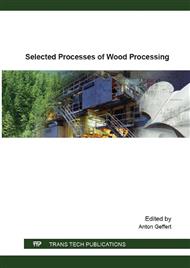[1]
M. Draxlerová, J. Harangózo, K. Balog, Effects of retardants on the ignition of wood materials, Environmental and Safety Aspects of Renewable Materials and Energy Sources, Advances Materials Research, 1001 (2014) 288-291.
DOI: 10.4028/www.scientific.net/amr.1001.288
Google Scholar
[2]
V. Veľková, E. Výbohová, T. Bubeníková, Negative Effect of Wood Impregnation on Environment, Acta Facultatic Ecologiae, 15 (2007) 65-70.
Google Scholar
[3]
J. Martinka, T. Chrebet, Activation energy of Teak and Oak wood spontaneous ignition. In: Advanced Materials Research, 1001 (2014) 262-266.
DOI: 10.4028/www.scientific.net/amr.1001.262
Google Scholar
[4]
I. Mitterová, M. Zachar, The comparison of flame retardants efficiency when exposed to heat, in: Modern trends in ergonomics and occupational safety. Zielona Góra, University of Zielona Góra, 2013, pp.207-226.
DOI: 10.15557/pimr.2021.0036
Google Scholar
[5]
E. Mračková, Problems of explosion in the division of woodworking industry, in: Čovek i radna sredina. Zaštita radne i životne sredine u sistemu nacionalnog i evropskog obrazovanja, Fakultet zaštite na radu Niš, 2005, pp.229-232.
Google Scholar
[6]
Q. Xu, X. Que, L. Cao, Y. Jiang, C. Jin, Study of heat flux distribution of wood crib fires: bench scale tests, Thermal Science, 14 (1) (2010) 283-290.
DOI: 10.2298/tsci1001283x
Google Scholar
[7]
S. Gašpercová, Ways of increasing the fire resistance of wooden structures, in: Environmental and safety aspects of fires and accidents, Materiálovotechnologická fakulta STU Trnava, AlumnilPress, 2010, pp.71-78.
Google Scholar


